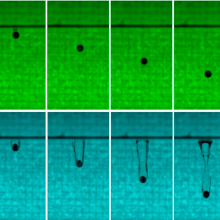SFB 1313 paper "Impact of a Linear Array of Hydrophilic and Superhydrophobic Spheres on a Deep Water Pool", published by Guang Yang (research project A02), Visakh Vaikuntanathan, Alexandros Terzis, Xin Cheng, Bernhard Weigand (research project A02) and Rainer Helmig (research projects A02 and C02).
Abstract
The impact of solid bodies on the free surface of liquid pools is involved in many practical applications—such as bullets and air-to-sea anti-torpedo defense systems, or the water entry of athletes in water sports—aimed at improving the performance through a control of cavity dynamics. This work reports an experimental investigation of the impact of a linear array of hydrophilic (H) and superhydrophobic (SH) spheres on a deep water pool. The array consisted of ten magnetic spheres, with different permutations of H and SH spheres. Using high speed shadowgraphy, we captured the underwater kinematics of the array for different permutations of H and SH spheres. In particular, we observed the evolution or absence of an air cavity attached to the array as a function of the position of the H and SH spheres. The position of the first SH sphere from the leading edge of the array (ZSH) emerged as a key parameter that alters the characteristics of cavity evolution. The appearance and pinch-off characteristics of a wake cavity behind the trailing edge were governed by the wetting propertiesoftheleadingandtrailingsurfacesofthearray.The position of the first SH surface, as well as the wetting characteristics of the leading and trailing surfaces, are potential control parameters to alter underwater cavity evolution during solid surface impact on deep water pools.


